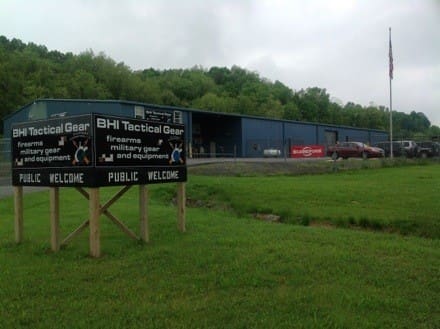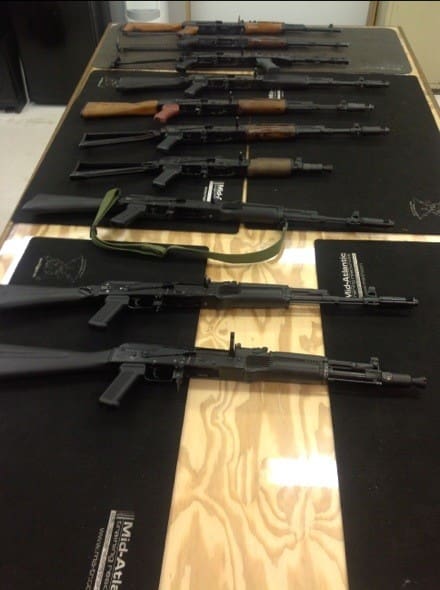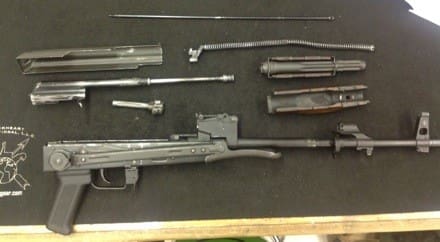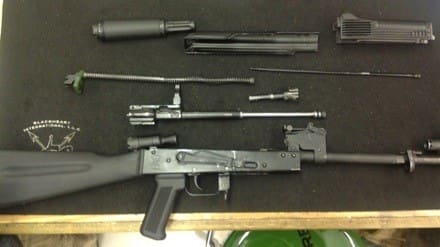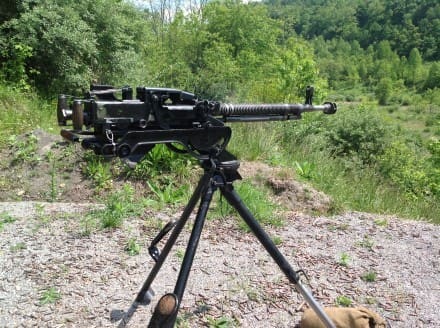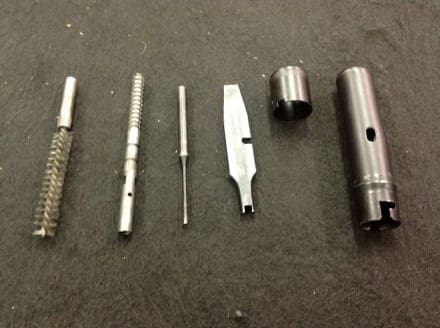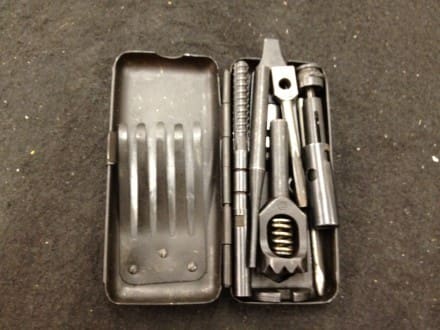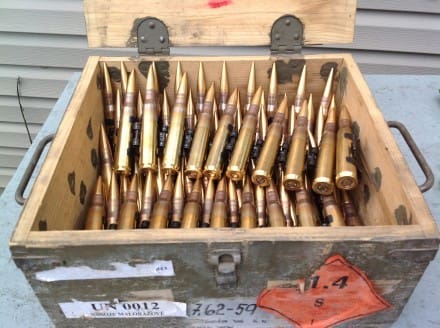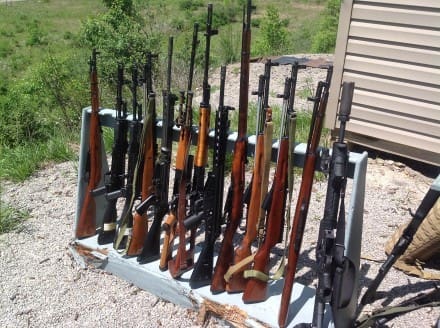Blackheart International Foreign Weapons Course
This article was originally serialized over five days and posted the following morning after each day of training. It has been combined here for convenience with slight modifications to the text to streamline continuity. I’ve also added a few comments as I’ve had time to digest the training.
Day 1
Welcome to day 1 of Blackheart International’s five-day Foreign Weapons Course. Bottom Line Up Front – Excellent. Once we got going, I quickly realized that this is not only a great course for trainers, advisors and shooters, but also for intel guys (both collectors and analysts) to acquaint themselves with the weapons in order to prepare more accurate reports.
Blackheart offers a very comfortable bunkhouse for students with full facilities including kitchen. Upon arrival, I settled right into my room. In the morning we arrived at their training facility and grouped up into Army and Navy tables. This is a class of mixed units so it is small. Usually, unit classes are much larger. Everything was very organized yet casual and you could tell that the instructors are well versed in their craft.
Right off the bat, we started off the course with a quiz, identifying weapon and associated caliber as well as a visual ID test of our knowledge of ammunition. Remember, this is a Foreign Weapons Course so for several of us (me included), the quiz was challenging. While I knew most of the calibers, I wasn’t familiar with what some of them looked like, particularly when paired next to each other.
We then set about going over pistols and SMGs, discussing origins, characteristics, loading, unloading, and maintenance. Each of us had our own weapons to practice with right along with the lecture. Remember those Army and Navy tables I mentioned earlier? When the primary instructor brought up the SIG family, the Army table hadn’t handled them much and when the subject turned to the Beretta, the opposite was true. Interesting that “standard” weapons for services can become an issue in a joint environment. Now, imagine being in a situation with combined forces (coalition).
After a working lunch we hit the 50m range and got to familiarize ourselves with the various guns, demonstrating proper handling from the morning’s classroom portion of training. During the range work, instructors would quiz us on handling and caliber of the various weapons which included the Tokarev, Makarov, PPSh-41, PPS-43, and Sten, among others.
Here’s a clip of me firing the PPSh-41. I don’t know if I enjoyed it or the Sten more, but I can tell you, anyone who carries a Sten into battle has big brass ones and strong thumbs. Sten mags are a chore to load. Although it was rainy, the temperature was comfortable and it let up for much of our two hours of shooting.
After the range we headed inside for weapons maintenance and were afforded the opportunity to break them down and give them a good going over (including magazines). Once all of the weapons and magazines had been squared away we each took our turn in the barrel with an end-of-day quiz. The instructors took all of the weapons apart and placed them in a pile along with dummy rounds corresponding to each weapon. One-by-one, we then had to assemble the weapons, answer any questions during reassembly, find the associated ammunition, properly name it and complete a function check. All of this repeated hands on helped really sink the material in. Tomorrow is a big day…AKs. I can’t wait.
Due to the duties of my fellow students there were few opportunities for pictures. I hope you understand.
Day 2
The AK family of weapons was the subject of day 2’s instruction. As soon as we took our seats we jumped right into two-and-a-half hours of lecture and discussion on the history and variants of the AK family of weapons. All the while, the instructors would quiz us on what we had just learned, further reinforcing the information with anecdotes. I began to see the significance of encountering certain variants and what that might imply. This block of instruction further instilled my thoughts that this is a great course for intel personnel as well as EOD. Oftentimes, they are the go to guys for info on munitions, but not necessarily on the actual weapons.
Once we were exposed to the different models of AKs and their naming conventions, we moved to hands-on work. First, the instructor demonstrated how to handle and maintain the most commonly found model; the AKM. Then he contrasted various differences between the models. Next, with each student working with a different weapon, we practiced loading and clearing them and then broke them down and put them back together. Then, we swapped weapons so that everyone got a shot at a couple of different variants.
Once we were on the range, teaching didn’t stop. Here, an instructor discusses the AK’s unique sighting system.
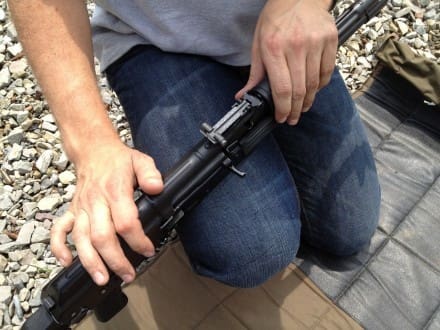
The BHI instructors took every opportunity to show us details on the weapons. While rare, stoppages were used as teaching points as well, helping us to earn about the root causes of malfunctions. We had ample opportunity to familiarize ourselves with both 7.62 x 39mm as well as 5.45 x 39mm AK variants in a variety of models and from a variety of manufacturers. For example, here I am, firing an AK-74.
After about an hour of familiarization, the steel targets came out and we moved back to 100 yards for some distance firing. After we were satisfied with our progress, we moved back once again to 200 yards and reengaged. This really demonstrated how the combat setting on the iron sights works and what is going on with the projectile.
Once back in the classroom, we once again broke the weapons down for cleaning which further reinforced the day’s instruction. After we were satisfied with our efforts, the Practical Exercise began. As with the day before, each student encountered a bench with a pile of parts, magazines and dummy ammunition from various weapons covered over the past two days. The point of the exercise was to separate the parts, build them into the proper weapon and associated magazine and ammunition and preform a function check. The student was expected to also be able to identify the proper nomenclature of the weapon and its ammunition and answer any other questions the instructor might have.
The constant reinforcement through verbal quizzing and hands on application is very effective and I am gaining a great deal of confidence in my ability to work with these weapons.
On day 3, we break out the DShKM. I can’t wait.
Day 3
On day 3, I had a rare opportunity to live fire a DShK (dush-kah) which is a Russian produced heavy machine gun. Blackheart International offers the only hands on, live fire instruction for heavy foreign weapons in the United States.
Day 3 of the BHI Foreign Weapons Course was all about Machine Guns…big, dangerous looking, Soviet Machine Guns. Over the course of a career, you might get to handle foreign weapons and maybe even shoot an AK, but rarely if ever do you get the opportunity to not only get into the nitty gritty of how to use and maintain them, but actually fire them as well. It’s training like this that promotes adaptability, going beyond simply demonstrating a capability to a student. Blackheart ensures you know how to do it.
Once again, we began the day with lecture, paired with hands-on application. Using the same methodology as previous days, our instructors gave us the history of each weapon followed by a demonstration on how to make it safe, load it, and maintain it. Due to the variety of machine guns we completed the lecture portion before starting a round robin with students rotating between the RPK, RPD, PKM and DShKM. In addition to the weapons themselves we also learned about accessories such as the tripods and cleaning kits. Below are examples of amazing cleaning kits provided to Russian troops with these weapons. Not shown is the DShK kit which includes a hammer!
Employment tips would come later in the day, at the range. We had one left to do before we could head out the door. After loading our DShKM links with specially produced 12.7 x 108mm ammo, we headed to the live fire range.
Once we set up the weapons, we were given the opportunity to load ammo belts and magazines and then put them to good use. The range was an unknown distance affair with various targets out to 800m. This meant that we would employ the range settings on the sights of the various weapons we had learned about during the morning’s classroom portion. Everything Blackheart does, builds on what is learned previously and reinforces it.
Firing the RPK
Firing the PKM
Firing the DShKM
We all also fired the RPD.
Then, we headed back to the classroom and cleaned the machine guns. This not only provided critical maintenance, but once again reinforced the day’s lessons. Due to the length of the training day, we capped it off with a written quiz on weapons nomenclature and calibers after a quick briefing on some of Blackheart’s other training courses and technologies.
Once the class arrived back at Sugar Creek Lodge, the class was surprised with a home cooked meal. Prepared by BHI’s very own Miss Carolyn, it was delicious and really hit the spot. Big thank you from all of us! It really means a lot to attend a course and be able to go back to a homelike atmosphere with all of the amenities. In addition to a great view of the West Virginia countryside, the lodge even has a workout room in the basement. Service like this allows you to concentrate on the training.
On day 4, we will familiarize ourselves with the RPG and get some hands on time with the SDV, Moisin Nagant, and SKS.
Day 4
On day 4 we concentrated on former Soviet bloc marksmanship weapons like the SVD and FRK (PSL) as well other foreign weapons such as the Moison Nagant, SKS, .303 Enfield, G3, and FN FAL. The SVD isn’t a sniper rifle by any stretch of the imagination. It just isn’t built to the accuracy level needed for true sniper operations but it does offer a more accurate alternative to the standard AK.
As usual the day began with lectures and hands on practice. This time with the RPG-7. Unfortunately, due to the availability of rounds, we were unable to do any live fire. This block of training was followed by Russian marksmanship weapons in addition to various .30 weapons from around the world.
Later in the day, at their unknown distance range, we employed the guns we went over in class as well as a couple of others. We also had the opportunity to fire the BHI-15 with SureFire mini suppressor. The video is of the FRK, also know as the PSL. Think of it as an AK blown up to 7.62 x 54R. It kicks pretty hard.
The day ended with a great deal of weapon cleaning and individual testing which consisted of a huge pile of parts laid out on a table. Students had to assemble the weapons and perform a function check, all the while answering questions regarding ammunition and nomenclature.
Day 5 will see the class meeting on the range to conduct some weapon drills followed by a final Practical Examination which is the culmination of everything we have learned. They’ve kept us in the dark about what will happen but I’ll tell you more in my next installment.
Day 5
Day 5 of the Blackheart International Foreign Weapons Course is test and graduation day. There are no photos of this final phase of instruction simply because it is an evaluation. However, here is what happens on a macro level. Day 5 is the culmination of everything we have learned. Ammunition ID is critical. All of those pile tests we accomplished at the end of each day come in very handy, and maintenance and manual of arms for each weapon is crucial to success. If you attend this course, your skills will be tested. Some would say that the training staff “fire hoses” the students over the course of the week, but there is enough practical application and hands-on reinforcement over the course of the week to make sure the material sinks in.
We reported to the range at 0730 and went right to work. Prior to testing (and after), all of the weapons were available for practice (take down and reassembly) as well as live fire on the main KD range. There was also a dueling tree set which led to some interesting competitions. How about a Sten gun versus a GLOCK?
One at a time, the students face the final evaluation on a separate range which cannot be observed by the other students. I am told by the instructors that no two students ever negotiate the course the same way and that strengths and weaknesses become glaringly apparent as the evaluation progresses.
In my case, it was most certainly true. I reduced all of the threats but fixated on placing a weapon into action that had been challenging to me during the week. Instead of using other resources to progress through the course of fire, I decided that it wasn’t going to “beat” me and I was going to make it work. I wasted time doing so and in a real-world situation could have exposed myself to danger. I already had plenty of resources for success but allowed myself to become myopic and really ramped up the stress in doing so. Once I felt my mouth go dry, I noticed the fine motor skills start to erode. I was placing a lot of stress on myself to succeed. Ultimately, I stopped what I was doing and used the other tools at my disposal to finish the evaluation. I learned a valuable lesson during that evaluation, and in speaking with my fellow students about their experience, I would say that they did too.
The facilities are great. I’ve talked about Sugar Creek Lodge with its weight room, wi-fi service and large eat-in kitchen and Wednesday night home cooked meal. When the course director told me via email, “Just bring your clothes and tooth brush,” he wasn’t far off. Over the week’s coverage, I’ve also mentioned in passing Blackheart’s 300 acre range facility with KD and unknown distance ranges. Lastly, the Headquarters and Training building houses the class room as well as a well stocked retail store. Everything is clean and well maintained.
The access to working weapons that you can actually fire is unparalleled. These includes the everything from the Makarov on the small end up to and including the DShKM in the heavy category. While in the service, several of my units had foreign weapons in the arms room but we never had any ammunition. At a minimum each student fires:
12.7 x 108 10 rds
7.62 x 54R 150 rds linked
7.62 x 54R 20 rds
7.62 x 51 50 rds
7.62 x 25 144 rds
7.62 x 39 440 rds
5.45 x 39 300 rds
9 x 18 50 rds
9 x 19 250 rds
I have a new found respect for Soviet-era weapons after this experience, particularly the Makarov due to its simplicitly and the PKM due to its reliability. Additionally, I found that the AK family of weapons can be effectively employed if you understand them and apply the fundamentals of marksmanship. The unknown distance range really helped me understand how to use the AK sighting system. I wish I would have taken this course 25 years ago.
This was a great course and I highly recommend it to anyone who requires knowledge of the identification, employment, and maintenance of foreign small arms. If you attend this course, expect long, challenging training days. But, you’ll learn a lot, both about the weapons and about yourself. Blackheart often tailors this course to the specific requirements of users so don’t hesitate to ask if they can support your requirement.
Thank you to Blackheart International and their entire staff for inviting me to this course and your support throughout the week.


